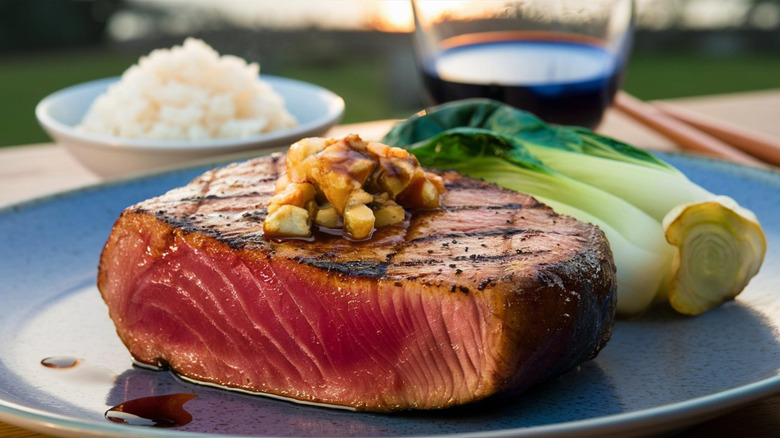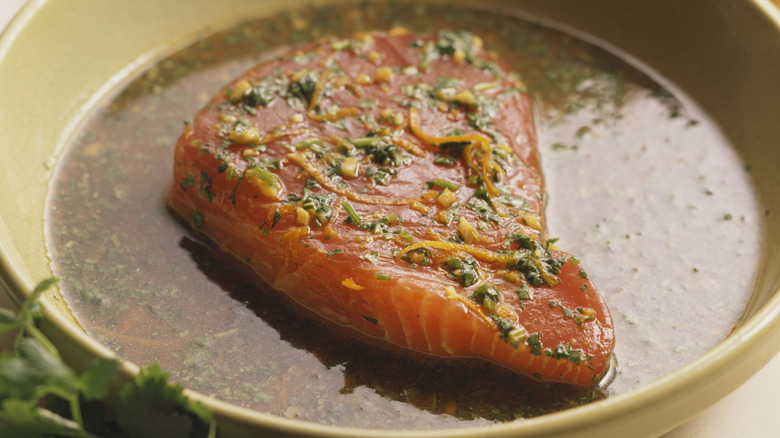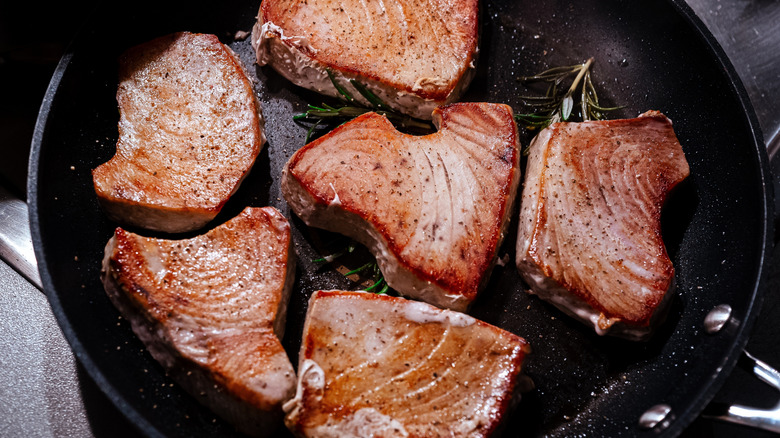The Ideal Temperature For Cooking The Best Tuna Steaks
Tuna is distinctive among fish for many reasons, but one in particular is that, in a world of obsessive temperature probing and "chicken anxiety," tuna is a fish most people are comfortable eating, essentially, raw — even in the comfort of their own homes. And though this might be the best way to enjoy tuna, much like getting a perfect medium-rare cook on steak, it can be difficult — or even intimidating — to achieve a perfect sear on a piece of tuna without overcooking the inside. To find out how to nail tuna every time, Food Republic asked Robert DiGregorio, director of seafood quality at Fulton Fish Market, for some tips.
"To ensure rare tuna steak — the way most people, myself included, prefer their tuna — cook it to an internal temperature of [65 to 70 degrees Fahrenheit]," DiGregorio told us. If you're looking at that temperature with a little incredulity, don't. "While that might seem low, the fish will continue to cook from residual heat, after coming out of a hot pan. A final internal temperature of about [95 to 100 degrees Fahrenheit] is perfect."
So, just like when you're cooking steak, allowing the fish to carry over and reach its final temperature is the way to go. To ensure you're spot on with your temperatures every time, use a temperature probe.
How to prepare tuna before cooking
When it comes to preparing your tuna to get the perfect rare cook, there's luckily not an awful lot you need to do. We asked Robert DiGregorio about his go-to method. "One of the great things about cooking tuna is its simplicity," he said. "When preparing the [tuna] steaks, I usually pat them dry and season generously with salt and pepper to bring out their flavor."
This is a great way of cooking tuna — it's a really flavorful fish on its own, and tastes a little like a super fresh steak: It's savory and fatty, yet simultaneously has that brightness that's characteristic of great seafood. It also doesn't really carry a "fishy" taste or smell at all, so you don't have to treat it beforehand to remove that, like you might for some other fish. Of course, if you fancy adding a little flair to spice things up, you could marinate your tuna before cooking it. What you marinate it in is up to you, but make sure you use one that's oil-based and has the basic building blocks of acid, savory, and sweetness. It'll impart a brilliant, complex flavor profile to your fish while also making it far more resistant to overcooking. In fact, for the most tender tuna steaks (even if you cook them to too high a temperature), try marinating your fish in mayonnaise!
The best method for cooking tuna steaks
So you've prepared your fish, it's been marinated (or not, depending on your taste), you've got your probe thermometer handy, and you're ready to cook. What now? Tuna is a super versatile fish — indeed, there seem to be almost innumerable ways to serve it, from crudo to tuna confit (a worthy upgrade to kick that canned tuna out of your cupboard) to steak-style, with a crunchy sesame crust. Robert DiGregorio prefers to keep things simple, fresh, and tasty: "There are a thousand ways to cook almost anything, but I like my tuna steaks pan-seared in a little oil."
Fish responds really well to being cooked super fast, over high heat, which helps it retain its freshness and really lock in those flavors while achieving a lovely brown crust on the outside. That's good news if you're a grill fanatic. "During the summer you can move the cooking outside and grill [the tuna]. Lightly oil the steaks first and cook over a hot grill[,] getting a good sear while still maintaining a rare interior." Just remember to keep an eye on that internal temperature, and for a perfect rare cook, pull it off the heat at that 65 to 70 degrees Fahrenheit mark.



